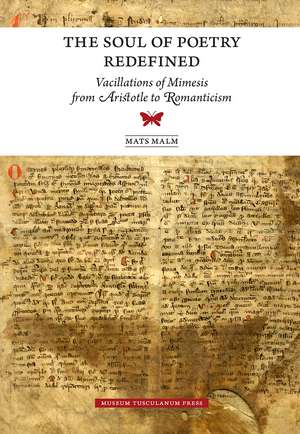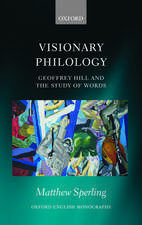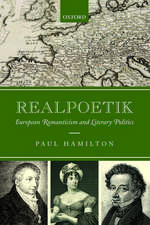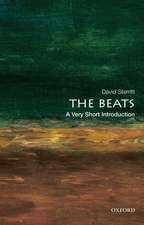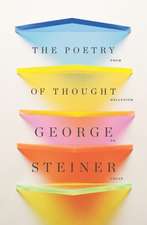The Soul of Poetry Redefined: Vacillations of Mimesis from Aristotle to Romanticism
Autor Mats Malmen Limba Engleză Hardback – 26 mai 2014
What is the soul of poetry? Perhaps the most influential answer comes from Aristotle’s Poetics, in which the writer regarded poetry as an instance of mimesis, a kind of representation or simulation. However, despite the significance he gave the term, Aristotle's use of the word mimesis was far from unequivocal, and over the centuries that have followed this inconsistency has stimulated a wealth of interpretations and debate. Tracking Poetics from its birth in rhetorical studies to its reception across the centuries until romanticism, Mats Malm here examines the many different ways scholars—from Averroës to Schlegel—have understood mimesis, looking at how these various interpretations have led to very different definitions of the soul of poetry.
Preț: 229.17 lei
Preț vechi: 260.99 lei
-12% Nou
Puncte Express: 344
Preț estimativ în valută:
43.85€ • 45.78$ • 36.29£
43.85€ • 45.78$ • 36.29£
Carte disponibilă
Livrare economică 14-28 martie
Preluare comenzi: 021 569.72.76
Specificații
ISBN-13: 9788763537421
ISBN-10: 8763537427
Pagini: 238
Dimensiuni: 162 x 241 x 33 mm
Greutate: 0.59 kg
Editura: Museum Tusculanum Press
Colecția Museum Tusculanum Press
ISBN-10: 8763537427
Pagini: 238
Dimensiuni: 162 x 241 x 33 mm
Greutate: 0.59 kg
Editura: Museum Tusculanum Press
Colecția Museum Tusculanum Press
Notă biografică
Mats Malm is professor of comparative literature at the University of Gothenburg.
Cuprins
Abstract
Acknowledgements
Introduction
The soul of poetry—the definition of mimesis
Mimetic variations
Overview
1. Aristotle
Two instances of mimesis
Poetics—rhetoric
Plato’s categories
Probability—verisimilitude
Points of departure
ADAPTATIONS
2. Averroës’s adaptation (12th–13th century)
The poetics of visuality
The place of metaphor
Averroës and the soul
The soul of poetry: muthos replaced by lexis
3. Mathias Lincopensis: Representation and revelation (14th century)
Master Mathias on literary presentation
From mimesis to representatio: fiction boiled down to metaphor
Revelation and poetics
4. The Italian Renaissance (16th–17th century)
Robortello
Castelvetro
Towards a new poetics of diction
Tesauro
The ambiguity of imitation—the ambiguity of verisimilitude
5. French classicism and the necessity of probability (17th century)
Corneille
Racine
6. The principle and polemics of the fine arts (18th century)
Charles Batteux: the fine arts reduced to a single principle
Fiction—representation
Poësie des choses and poësie du style
Schlegel’s critique
7. The nachleben of imitation (early 19th century)
BEYOND ARISTOTELIAN CONCEPTS
8. The technique of the sublime (3rd–18th century)
The explicit argument
The implicit argument
The figure of the sublime
The terminology of the sublime
Fantasy merges with fantasy
9. The symbol and the categories of rhetoric
Definitions of the symbol
Outside the system of tropes
The word symbol
Poetry, painting, symbolism and visuality
10. Emotions and the system of genres
The instrumental emotions
The emotions turned into objects of poetry
From instrument to object—to soul
Conclusion
Notes
Bibliography
Index
Acknowledgements
Introduction
The soul of poetry—the definition of mimesis
Mimetic variations
Overview
1. Aristotle
Two instances of mimesis
Poetics—rhetoric
Plato’s categories
Probability—verisimilitude
Points of departure
ADAPTATIONS
2. Averroës’s adaptation (12th–13th century)
The poetics of visuality
The place of metaphor
Averroës and the soul
The soul of poetry: muthos replaced by lexis
3. Mathias Lincopensis: Representation and revelation (14th century)
Master Mathias on literary presentation
From mimesis to representatio: fiction boiled down to metaphor
Revelation and poetics
4. The Italian Renaissance (16th–17th century)
Robortello
Castelvetro
Towards a new poetics of diction
Tesauro
The ambiguity of imitation—the ambiguity of verisimilitude
5. French classicism and the necessity of probability (17th century)
Corneille
Racine
6. The principle and polemics of the fine arts (18th century)
Charles Batteux: the fine arts reduced to a single principle
Fiction—representation
Poësie des choses and poësie du style
Schlegel’s critique
7. The nachleben of imitation (early 19th century)
BEYOND ARISTOTELIAN CONCEPTS
8. The technique of the sublime (3rd–18th century)
The explicit argument
The implicit argument
The figure of the sublime
The terminology of the sublime
Fantasy merges with fantasy
9. The symbol and the categories of rhetoric
Definitions of the symbol
Outside the system of tropes
The word symbol
Poetry, painting, symbolism and visuality
10. Emotions and the system of genres
The instrumental emotions
The emotions turned into objects of poetry
From instrument to object—to soul
Conclusion
Notes
Bibliography
Index
Recenzii
“A valuable contribution to the study of mimesis and of the long-standing influence of Aristotle in Western aesthetics.”
“‘Aristotle, I have been told, has said that Poetry is the most philosophical of all writing . . .’ Carefully holding Aristotle’s Poetics at a distance while yet claiming it as a critical authority, Wordsworth’s bit of hearsay in the preface to Lyrical Ballads is a rhetorical gesture with a long history. The poet was but one in a long line of writers eager to cite Aristotle’s poetic dicta while radically and fruitfully redefining the basic terms of Aristotle’s argument. Mats Malm’s The Soul of Poetry Redefined represents a welcome attempt to clarify the various, ever-changing meanings attached to some of these basic terms—most notably mimesis, diction, and verisimilitude—amid the reception and interpretation of the Poetics from the twelfth to the eighteenth century.”
